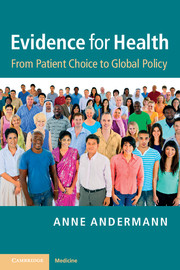Book contents
- Frontmatter
- Contents
- Foreword
- Preface
- Endorsements
- About the author
- Acknowledgments
- 1 Introduction
- 2 Strategies for improving health
- 3 Understanding how decisions influence health
- 4 Producing evidence to inform health decisions
- 5 Facilitators and barriers to using evidence
- 6 Making evidence-informed decisions
- 7 Conclusion
- Index
- References
2 - Strategies for improving health
Published online by Cambridge University Press: 05 February 2013
- Frontmatter
- Contents
- Foreword
- Preface
- Endorsements
- About the author
- Acknowledgments
- 1 Introduction
- 2 Strategies for improving health
- 3 Understanding how decisions influence health
- 4 Producing evidence to inform health decisions
- 5 Facilitators and barriers to using evidence
- 6 Making evidence-informed decisions
- 7 Conclusion
- Index
- References
Summary
Almost 40 years ago, the Declaration of Alma-Ata set forth the aspirational goal of “health for all”. While a great deal of progress has been made in recent decades, there remain many important decisions still to be made if we want to come even closer to achieving this goal. However, if the aim of making more evidence-informed decisions is to improve health, it would be helpful to first know what health is. While this appears to be a rather straightforward question, as Socrates found over two millennia ago, many people, when pressed, have difficulty defining even the most fundamental concepts – like knowledge and justice – that are central to their everyday lives. Similarly, health and health inequities are also basic concepts that should be explored further from the outset. What is health? Why should we want to improve health? What are the most effective strategies for improving health? How can we measure whether there have been health improvements? This chapter provides an overview of the concepts of health and health inequities, of the causes of poor health, and of the various strategies to improve health and reduce health inequities.
Health and health inequities
Health is a complex concept that can be examined and defined in many different ways. A widely used definition is inscribed in the 1948 constitution of the World Health Organization (WHO), which considers health to be “a state of complete physical, mental and social well-being and not merely the absence of disease or infirmity”. This definition moves away from a strictly biomedical model of health that focuses only on the disease or disability. Instead, the WHO definition adopts a wider bio-psycho-social model to better integrate the importance of the psychological and social dimensions of health. One might go even further and include a spiritual dimension of health. According to the Canadian Royal Commission on Aboriginal Peoples, many indigenous communities consider health to be “a state of balance and harmony involving body, mind, emotions and spirit. It links each person to family, community and the earth in a circle of dependence and interdependence, described by some in the language of the Medicine Wheel”. Health is therefore a holistic and multidimensional concept that must be explored from different angles and perspectives to be fully understood (Fig. 2.1).
- Type
- Chapter
- Information
- Evidence for HealthFrom Patient Choice to Global Policy, pp. 5 - 25Publisher: Cambridge University PressPrint publication year: 2012



